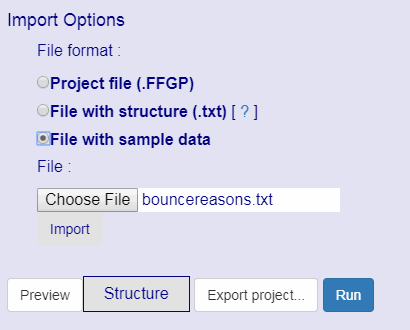Our online test data generation service is available at www.sqledit.com/g.aspx It seems very easy to use and very limited. This article describes a few hidden features of the tool. We'll explain how to create more realistic data with this service.
By default, the service offers about 20 built-in generators. There are some random values (numbers, strings, dates) and some predefined lists (companies, departments, cities, countries, etc). The user enabled to combine them to create own data file. Most generators can parameters to tune the generation process. For example, the user can provide the range of numbers to be generated: "Random Number": 100, 200 means integer between 100 and 200. Under the hood, it is $Rint engine function call (the generator shows actual call text in the preview). The user can refer to the engine manual for detailed information about each function parameters and options at www.sqledit.com/dg/engine_help/index.html.
The built-in generators do not allow the user to create really complex data. To extend the basic functionality the on-line service supports two features: generation by regular expression and custom generators. We will not here go into regular expression use for the generation (please read this article for details).
Let us provide a few examples of custom generators use for complex data creation. The custom generation is an expression compatible with mentioned above Test Data Generation Engine that provides about 80 built-in functions, expression engine, etc. Please be noticed that the on-line service does not allow you to use expressions larger 75 symbols.
The first example generates IP-addresses. Just use the following pattern to generate a four 1 to 255 integer values separated by the dot:
$Rint(1,255).$Rint(1,255).$Rint(1,255).$Rint(1,255)
The second example is phone number with 4-digits extension. We should generate zone (will use +1 only), area code, number, and extension:
+1 \(NNN\) NNN-NNNN NNNN
The last example shows reference between columns. We've defined the first column as a number between 10 and 20 and the second as a square of the first one:
$$(@1*@1)

Structure definition options
The online service provides four ways to define the structure of output file.
The first one is the default. It is a manual structure definition. The second is opening an existing project that compatible with DTM Flat File Generator. Our online service can import column names and defined generators from .FFGP file.
The next way is to define a file structure in the text file and import it by the service. And the last one is structure import from existing data file:

Limitations
However, the on-line generator has a few true limitations. There are local files and other data sources access, a number of columns and rows to be generated. Also, the on-line data generator does not support a few modern functions like array generators or JSON generators.
To avoid web-server overloading we have limited number of columns by 32 and number of rows to 500. Nevertheless, our DTM Flat File Generator uses the same project file format and has no mentioned limitations. Just download your project file from the online service and use. The only required change is output file name assigning.